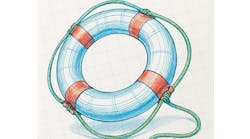By Dan Hebert, PE
What does it take to get a 5 in our Readers Choice customer service ratings? Being the kind of vendor that steps up to the plate when an end users needs help. Sounds obvious, but it’s a basic skill some companies never seem to master.
Some vendors spend megabucks on sales and marketing and forget that few things are more frustrating to an end user than wasting time dealing with poor customer service. They also may forget that it only takes one negative experience to sour an end user on a company for life.
When a vendor has you locked in because it is the only company that makes a particular product or because the cost of switching is prohibitive, customer service or lack of it may cause headaches and be frustrating, but you may not have any real choice. However, when you have options because a product has been commoditized by open standards, customer service can be the main factor in vendor selection.
While the automation marketplace is nowhere near as open as we would like, the situation is better than it was in the last century, when the big DCS vendors tended to own their customers and often treated them with disdain. Nowadays, customers often have the upper hand and can force vendors to provide superior service or lose their business.
“Customer service is a large part of the equation in an automation buying decision,” says David DeBari, a senior process engineer with ExxonMobil Chemical, Houston. “Functionality, ease of use and value get you to a short list of vendors. The next cut is made on technology, experience and customer service.”
“Customer service is absolutely essential, and we view it as a key feature, just like the physical functionality attributes of a product,” says Wright Sullivan, president and founder of system integrator A&E Engineering, Greenville, S.C. (www.aeengr.com). “If the hardware and software meet the goals of the project, then customer service is everything. We will buy from people who we know will support us in achieving our objectives.
|
“Our clients value customer service very highly when they choose integrators, and we expect our suppliers to operate at the same level of responsiveness that we provide to our clients. We have to move at the lightning speed of customers expectations, and we expect our suppliers to support us and deliver to those same expectations,” concludes Sullivan.
Customer service is often a direct determinant of project success or failure. “Customer service is a very high priority for us and for our clients, and it is a significant part of the buying decision,” says Bob Rutemiller, president of system integrator Automation Consulting & Education (ACE) in Tampa, Fla.
“If you are in the middle of a project and have a question, the ability to get knowledgeable and competent help on the phone or by email quickly has a direct effect on the project outcome. Good support can minimize on-site time and cutover time and can ultimately affect the profitability of the project and satisfaction of the end user,” adds Rutemiller.
One of the key factors currently elevating the importance of customer service is the lack of automation staff at process plants. As staff dwindles, each employee is asked to do more with less and has less time to do it. “With the worldwide trend of leaner staffing, vendors have to provide great support to compensate for lower levels of internal resources,” observes DeBari.
Read on to find out what end users in the process industries are demanding from their suppliers when it comes to customer service.
Driving Customers Away
Follow along as the largest process company in the world is put through customer service hell. “We were trying to understand how to configure communications with a feeder system, and the documentation was difficult to follow and seemingly incomplete,” relates DeBari. “I called the vendor and was talked through a few settings. I was then told the feeder system should be working, but it was not.”
“I spent several hours reading the manuals, double checking the settings, and performing the troubleshooting steps. I called the vendor back and talked to another support engineer who led me through the same steps as the first support person and gave the same diagnosis: It should be working,” continues DeBari.
“By the next day I was staring at a fix-or-replace decision. I called the vendor and talked to a third support person. This time, I was told that the documentation was incomplete and incorrect in places. Turns out the issue I was having was common, and this third person helped me corrected the problem within an hour. But the damage was done after three support calls and almost two days of lost time. I decided that I would try hard to prevent my company from purchasing future equipment from this vendor,” concludes DeBari.
When it comes to poor customer service, major end users are not the only victims. Bob Swarner, a systems engineer with systems integrator AAA Absolute Automation and Electrical Services in Covington, Ga. (www.AAAelectricalservices.com), relates his travails.
“We needed a replacement 150HP drive for an agitator motor in a chemical reactor,” he says. “The drive went out during the middle of a production run at a customer’s facility, so time was of the essence to avoid losing the batch. We contacted our salesman from the drive supplier, and he said he would check availability and be right back with us. After three hours, we had still not heard anything, so we contacted the supplier’s branch manager, who quickly told us a replacement was available in a nearby location. Precious hours were wasted waiting for the salesman’s promised call.”
Customer service problems often arise when vendors misrepresents or oversell their products. “We sourced an OPC server and hardware from a vendor who claimed its products were OPC-compliant. Come to find out the products were not truly OPC-certified or compliant. The vendor was not able to address the issues, and it caused a one-year delay and a loss on the project,” explains Rutemiller of ACE.
The most effective phone support occurs when vendors stage hardware and software in configurations similar to their customers’ systems.
(photo courtesy of AutomationDirect)
When a vendor alienates a system integrator with poor customer service, it can have a negative multiplier effect because the integrator often influences a number of end users. On the other hand, making an integrator happy multiplies benefits throughout the integrator’s customer base.
Creating Brand Loyalty
Poor customer service can alienate a customer for life, but superior customer service creates intense brand loyalty. “We were on a service call with a new client and needed a repair part as soon as possible to make a good impression with this potential new account. We did not have a parts catalog handy, and the part numbers were missing from the components. We contacted the technical support department of the vendor, AutomationDirect (www.automationdirect.com), and they helped us order the correct components. We had the parts ready for pickup in under an hour,” says Swarner of AAA.
ExxonMobil’s DeBari relates his customer service success story. “I had a new fieldbus instrument that was not reporting the correct value. I called Emerson Process Management’s (www.emersonprocess.com) 800 number and was talked through the proper configuration within five minutes. The assistance was expert, easy-to-follow and quick. Just 15 minutes after starting to work this issue, I was on to the next task,” says a satisfied DeBari.
Software problems can be especially frustrating, and a knowledgeable vendor can be a lifesaver. “We were doing a lift station monitoring and control project, and we chose Software Toolbox (www.softwaretoolbox.com) as our supplier because of prior positive experiences with their support,” says Rutemiller of ACE. “Once again, Software Toolbox was incredibly responsive to our needs. They overcame a six-hour time difference and were able to work with hardware from a supplier in Australia. Software Toolbox worked setup test benches at their offices that duplicated our field setup, and they helped us make sure we got all the results we needed when we needed them.”
When a complex problem needs to be solved, nothing beats two engineers working side by side.
(photo courtesy of Software Toolbox)
Perhaps the most impressive displays of customer service occur when a vendor agrees to fix another supplier’s problem. “We bought an OPC Server from a vendor, and we were having trouble getting it to work. From prior experience, we knew that the folks at Software Toolbox were OPC experts, so we turned to them,” says A&E Engineering’s Sulivan.
“They put aside other work and helped our engineer solve our problem for a very reasonable fee. When the chips were down and we needed help, Software Toolbox came through for us. The fact that they made time to help with another vendor’s problem speaks volumes about how much they care about us and their clients,” concludes Sullivan.
Problems Are Opportunities
One constant shines through in positive customer service experiences: A customer problem can be a great opportunity for a vendor to prove its worth. No vendor is perfect, and no reasonable customer expects them to be. Customers instead judge vendors on their performance under duress.
“We judge customer service on how a supplier responds to a problem. So many suppliers are sales-focused that when the inevitable problems arise, they don’t see it as an opportunity, and they don’t do what it takes to recover. Suppliers don’t realize that problem resolution is their time to shine,” says Sullivan.
When a vendor looks at customer service as an opportunity to cut costs, the short term results are invariably very positive from a bottom-line perspective. Poor customer service doesn’t immediately impact sales; it instead negatively influences customers when it comes time to make the next buying decision.
This time lag between poor customer service and declining sales often leads to the temptation to cut customer service expenses, and outsourcing is often the vehicle of choice for saving money. Outsourcing relatively simple customer issues can often be a viable course of action. But in the automation industry, most customers are technically competent and can solve simple problems themselves.
What smart customers need are product experts at their beck and call when tough technical issues arise. Customers don’t mind paying for this expertise, and that is why many of them turn to system integrators to solve some of their most vexing technical issues. Local distributors can be another good source for customer service, provided the distributor has knowledgeable personnel available.
One solution is for vendors to provide a base level of customer service without charge and truly expert advice via a fee-for-service arrangement. No one should have to pay to have basic questions answered, but vendors also need to be compensated when their experts are assigned to solve complex issues.
Customers tend to remember the outcome of a service issue independent of cost incurred. Free and poor customer service is never appreciated. Great customer service accompanied by a reasonable fee is.
There are many different ways for vendors to provide and receive compensation for customer service, the key is for each vendor to realize the critical nature of their responses to customer problems. The message from end users is that for vendors the choices are stark: Provide great service and create intense brand loyalty, or drop the ball just once and lose a major account for years to come.
Dan Hebert is Control’s senior technical editor.
Latest from Home

Leaders relevant to this article:





